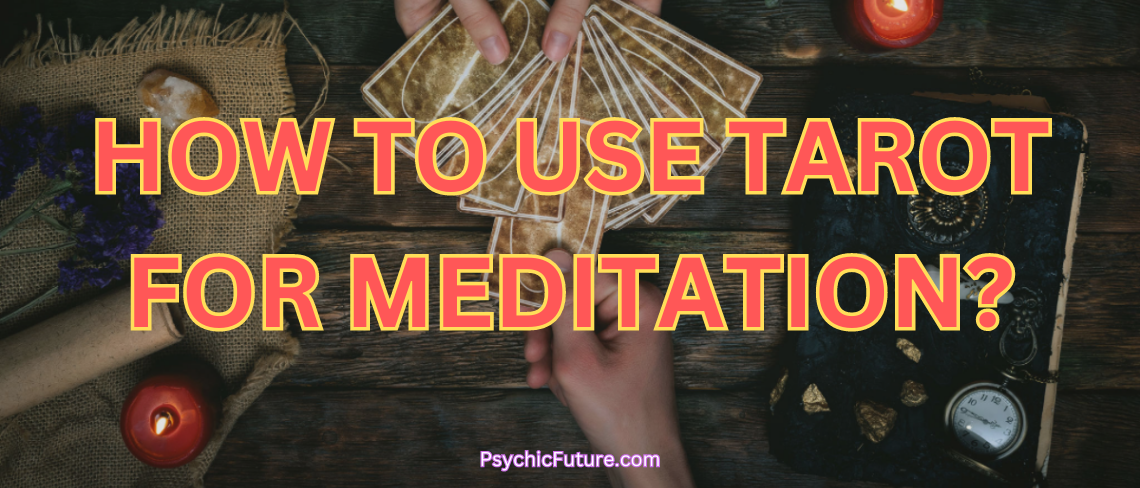Meditation and tarot may seem like different worlds. One is about turning inwards, calming the mind and seeking inner peace. The other involves external cards and interpreting their imagery. But the truth is, tarot and meditation can complement each other wonderfully, enriching your understanding and experiences in both practices.
What is Tarot Meditation?
Tarot meditation is an excellent method for self-discovery and personal growth. It involves focusing on a chosen tarot card during your meditation practice, exploring its symbolism, and applying its lessons to your life.
This practice helps you delve into the subconscious mind, encouraging introspection, personal insight, and a deeper understanding of tarot cards. Let’s dive in and discover how you can use tarot for meditation.
Step 1: Choose Your Tarot Card
Your first step is selecting a tarot card to meditate on. You can either pull a card at random or choose one that you feel drawn to or wish to understand better.
You could pick a card that represents a situation you’re dealing with or a quality you wish to cultivate. For instance, if you’re seeking strength and resilience, the Strength card would be an excellent choice. Conversely, if you’re wrestling with your shadow side, you might choose the Moon card.
Step 2: Set Up Your Meditation Space
Find a quiet, comfortable place where you can meditate without interruptions. It should be somewhere you feel safe and relaxed.
You might want to create an altar with the chosen card as the centrepiece. Feel free to add any items that resonate with the theme of the card or support a calming atmosphere, such as candles, crystals, incense, or soothing music.
Step 3: Familiarise Yourself with the Card
Before you dive into your meditation, spend a few moments studying your chosen tarot card. Observe the colours, the characters, the objects, and the overall scene depicted. What emotions does it evoke? What thoughts come to mind?
Take your time to note down these initial impressions. You don’t have to know the standard interpretation of the card at this point. The purpose here is to understand your personal reaction to the imagery.
Step 4: Begin the Meditation
Start your meditation by getting into a comfortable position and closing your eyes. Take a few deep breaths, allowing your body to relax and your mind to quieten.
Once you feel calm and centred, bring the image of the tarot card into your mind. Try to recall as many details as you can.
Step 5: Dive Deeper into the Imagery
As you hold the image of the card in your mind, let your imagination explore it further. Picture yourself stepping into the card. Interact with the characters, touch the objects, and feel the atmosphere.
Ask the characters questions or let them guide you through the scene. Stay open and curious, and see what insights come forth.
Step 6: Apply the Insights to Your Life
After your exploration, gently withdraw from the scene and bring yourself back to your physical surroundings. Open your eyes and write down your experiences.
Reflect on the insights you’ve received. How do they relate to your life or the situation you’re dealing with? How can you apply the lessons from the card in your daily life?
Step 7: Practice Regularly
Like any other practice, the more often you do tarot meditation, the deeper and more profound your experiences will be. Try to make it a regular part of your routine, even if it’s just once a week.
Tips for Tarot Meditation
Here are a few additional tips to enhance your tarot meditation practice:
1. Start with the Major Arcana: If you’re new to tarot, consider starting your meditations with the Major Arcana cards. These cards represent significant life lessons and archetypal energies, providing rich material for exploration.
2. Trust your intuition: When it comes to interpreting the card or applying its lessons, trust your intuition. Tarot is a personal journey, and your inner wisdom knows best what you need.
3. Be patient: Don’t be discouraged if you don’t get profound insights right away. Sometimes, the wisdom of tarot unfolds over time. Keep practicing, and you’ll gradually deepen your connection with the cards.
Conclusion
Tarot meditation is a unique and powerful tool for personal growth. By blending the introspective power of meditation with the rich symbolism of tarot, you can unlock deeper levels of understanding and wisdom. Take your time, trust the process, and let the cards guide you on your inner journey.
For further information and guidance on the art of tarot, books such as “78 Degrees of Wisdom” by Rachel Pollack and “The Tarot: History, Symbolism, and Divination” by Robert M. Place are highly recommended. Websites like Biddy Tarot (www.biddytarot.com) and Labyrinthos (www.labyrinthos.co) also provide a wealth of free resources for tarot learners.
Remember, the journey into tarot is an exploration of the self. Use your findings as a compass, guiding you to the wisdom you seek. Happy meditating!
References:
– Pollack, R. (1997). 78 Degrees of Wisdom. Thorsons.
– Place, R.M. (2005). The Tarot: History, Symbolism, and Divination. Penguin.
– Biddy Tarot. (n.d.). Biddy Tarot. [online] Available at: https://www.biddytarot.com/
– Labyrinthos. (n.d.). Labyrinthos. [online] Available at: https://labyrinthos.co/



